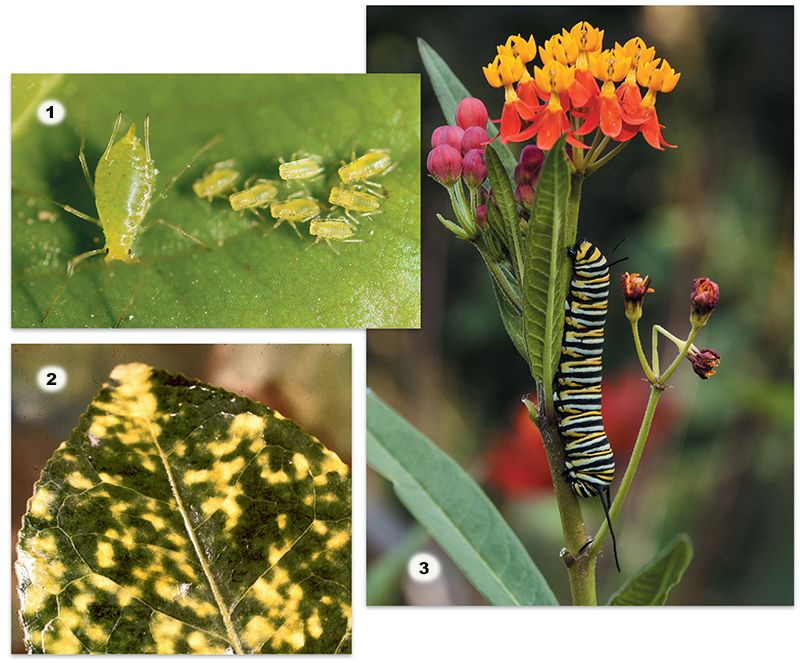Learn how to fend off the biggest plant pests—and when you should roll out the welcome mat

1. Aphids suck sap, leaving a sticky “honeydew” behind. 2. Scale have been feeding on the underside of this camellia leaf, turning it yellow. 3. Milkweed serves as the sole food source of monarch butterfly caterpillars.
Something demolished your fennel, seemingly overnight. Your tomato crop looked perfect...until the foliage turned brown. And what is that icky white stuff covering your echinacea leaves?
Identifying problems in the landscape—then figuring out how to fix them—can be daunting. Here to help: Catherine McGuinn, a district specialist with Clemson University’s Department of Plant Industry. “The three common pests doing damage in Lowcountry summer gardens are aphids, scale, and caterpillars,” she says. She talked us through the basics on each (and suggests hgic.clemson.edu for more info).
1. Aphids
■ What they are: Tiny yellow, green, or brown insects that colonize to zap plants’ sap
■ Plants they attack: Loads of edibles (such as tomatoes, peppers, leafy greens, and basil) and ornamentals (including roses and zinnias)
■ Signs of trouble: Misshapen, curling, or yellowing leaves; deformed fruit; and “honeydew,” a sticky excretion that can turn black with sooty mildew. Find the pests on young, tender growth and the undersides of leaves.
■ How to attack back: Invite in aphids’ natural predators, ladybugs and lacewings (who, by the way, are killed by broad-spectrum insecticides). “Alyssum is the very best plant for attracting adult lacewings,” says McGuinn. They’ll join ladybugs in eating from angelica and calendula, plus the flowers of fennel and cilantro. Additionally, McGuinn advises, “Tolerate some aphids, because momma won’t lay her eggs where there isn’t at least a small infestation for the larvae to eat after they hatch.”
2. Scale
■ What they are: White, grey, or brown sap-sucking pests that generally look roundish or rod-shaped
■ Plants they attack: Trees, shrubs, ground covers, and turfgrass
■ Signs of trouble: Withered or sickly plants, yellowing leaves, and clusters of the insects themselves—they’re sometimes mistaken for a fungal disease because of the way they convene on leaves, branches, and trunks.
■ How to attack back: Smother scale with horticultural oil sprays, which are more effective than chemical insecticides and less harmful to beneficial insects. Read product labels carefully, paying attention to guidelines on plant sensitivity and temperature restrictions. To protect the likes of ladybugs and lacewings, apply the oil in the early evening and when the affected plant is not in bloom. Know that to truly banish these bad guys, you may have to reapply several times.
3. Caterpillars
■ What they are: The larvae form of butterflies or moths
■ Plants they attack: Monarch caterpillars stick to butterfly weed; other butterfly varieties enjoy dill, fennel, swamp hibiscus, sage, and yarrow. Moth caterpillars dine on everything from trees to garden veggies.
■ Signs of trouble: Ragged holes in leaves and defoliated plants
■ How to attack back: First, identify the caterpillar. “If it’s turning into a butterfly, like a monarch or swallowtail, sacrifice your plant for the greater good,” urges McGuinn. If you’re up against a future moth and it’s causing serious damage, you may choose to remove the critters by hand, pinching them or dropping them into soapy water. Insecticides are available, “but they’ll kill the butterflies too,” she warns. For tips on evading specific varieties of caterpillar, visit hgic.clemson.edu.
Photograph courtesy of (camellia leaf) Clemson Cooperative Extension